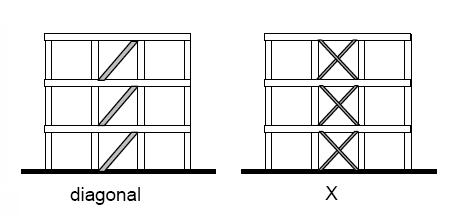Tygra_1983
Student
- Oct 8, 2021
- 125
Dear all,
I am wishing to do preliminary analysis on the horizontal deflections at the top of tall structures. Below, though it is not a tall structure shows the configurations of a rigid frame with bracing. I would like to calculate the deflection for a similar structure, just that, I use 15, 20, 30 plus storeys.

Thus far, I have found formulas to calculate the deflections of a rigid frames alone. These come in the form of:
deltaf = w*H^4/(8*E*I) for the flexural deflection of the whole building
deltaS = V*h^3/(sumC*12*E*Ic) + V*h^2*L/(sumB*12*E*Ib) for the shear deflection for each storey
Where:
w = horizontal uniform load
H = building height
h = storey height
L = is the beam length
E = modulus of elasticity
I = second moment area of the frame system
V = average cumulative shear
Ic = second moment area of the columns
Ib = second moment of area of the beams
sumC = number of columns per storey
SumB = number of beams per storey
Total deflection at top = deltaf + deltaS*(number of storeys)
So, I am sorted with deflection of rigid frames alone, but now I want to calculate the deflection if bracing is added - which will obviously reduce the deflection. I feel I have exhausted
my search on the internet for papers and in text books, and cannot find anything that will help me with this specific problem. Thus, I am really hoping someone on here can assist me on this? Is there an amendment to the above formulas I can make? Or is there any other formula/method that someone here could reveal to me?
Best wishes
I am wishing to do preliminary analysis on the horizontal deflections at the top of tall structures. Below, though it is not a tall structure shows the configurations of a rigid frame with bracing. I would like to calculate the deflection for a similar structure, just that, I use 15, 20, 30 plus storeys.

Thus far, I have found formulas to calculate the deflections of a rigid frames alone. These come in the form of:
deltaf = w*H^4/(8*E*I) for the flexural deflection of the whole building
deltaS = V*h^3/(sumC*12*E*Ic) + V*h^2*L/(sumB*12*E*Ib) for the shear deflection for each storey
Where:
w = horizontal uniform load
H = building height
h = storey height
L = is the beam length
E = modulus of elasticity
I = second moment area of the frame system
V = average cumulative shear
Ic = second moment area of the columns
Ib = second moment of area of the beams
sumC = number of columns per storey
SumB = number of beams per storey
Total deflection at top = deltaf + deltaS*(number of storeys)
So, I am sorted with deflection of rigid frames alone, but now I want to calculate the deflection if bracing is added - which will obviously reduce the deflection. I feel I have exhausted
my search on the internet for papers and in text books, and cannot find anything that will help me with this specific problem. Thus, I am really hoping someone on here can assist me on this? Is there an amendment to the above formulas I can make? Or is there any other formula/method that someone here could reveal to me?
Best wishes
